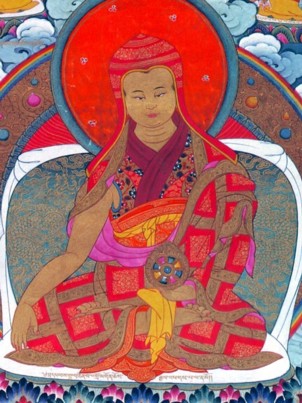Chögyal Pakpa: Difference between revisions
Jump to navigation
Jump to search
No edit summary |
No edit summary |
||
| Line 1: | Line 1: | ||
[[Image:Chogyal Phakpa.jpg|frame|'''Chögyal Pakpa''']] | [[Image:Chogyal Phakpa.jpg|frame|'''Chögyal Pakpa''']] | ||
'''Chögyal Pakpa''' (Tib. ཆོས་རྒྱལ་ཕགས་པ་, [[Wyl.]] ''chos rgyal phags pa'') (1235-1280) — the hierarch of the [[Sakya]] school who was recognized as the ruler of Tibet by Kublai Khan during the Yuan dynasty. He was also the nephew of [[Sakya Pandita]]. | '''Chögyal Pakpa''' (Tib. ཆོས་རྒྱལ་ཕགས་པ་, [[Wyl.]] ''chos rgyal phags pa'') (1235-1280) — the hierarch of the [[Sakya]] school who was recognized in 1253 as the ruler of Tibet by Kublai Khan (1215-1294) during the Yuan dynasty. He was also the nephew of [[Sakya Pandita]]. | ||
==Internal Links== | ==Internal Links== | ||
Revision as of 03:53, 17 January 2017

Chögyal Pakpa (Tib. ཆོས་རྒྱལ་ཕགས་པ་, Wyl. chos rgyal phags pa) (1235-1280) — the hierarch of the Sakya school who was recognized in 1253 as the ruler of Tibet by Kublai Khan (1215-1294) during the Yuan dynasty. He was also the nephew of Sakya Pandita.
Internal Links
- Five Sakya patriarchs
- Dzongsar Monastery
- Throneholders of the Sakya school
- Thirty-Seven Point Mandala Offering